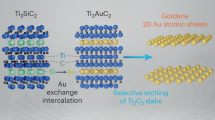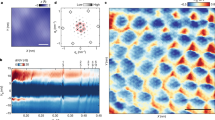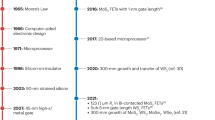Abstract
Although an isolated individual molecule clearly has only one ionization potential, multiple values are found for molecules in ordered assemblies. Photoelectron spectroscopy of archetypical π-conjugated organic compounds on metal substrates combined with first-principles calculations and electrostatic modelling reveal the existence of a surface dipole built into molecular layers. Conceptually different from the surface dipole at metal surfaces, its origin lies in details of the molecular electronic structure and its magnitude depends on the orientation of molecules relative to the surface of an ordered assembly. Suitable pre-patterning of substrates to induce specific molecular orientations in subsequently grown films thus permits adjusting the ionization potential of one molecular species over up to 0.6 eV via control over monolayer morphology. In addition to providing in-depth understanding of this phenomenon, our study offers design guidelines for improved organic–organic heterojunctions, hole- or electron-blocking layers and reduced barriers for charge-carrier injection in organic electronic devices.
This is a preview of subscription content, access via your institution
Access options
Subscribe to this journal
Receive 12 print issues and online access
$259.00 per year
only $21.58 per issue
Buy this article
- Purchase on Springer Link
- Instant access to full article PDF
Prices may be subject to local taxes which are calculated during checkout






Similar content being viewed by others
References
Michaelson, H. B. The work function of the elements and its periodicity. J. Appl. Phys. 48, 4729–4733 (1977).
Skriver, H. L. & Rosengaard, N. M. Surface energy and work function of elemental metals. Phys. Rev. B 46, 7157–7168 (1992).
Smoluchowski, R. Anisotropy of the electronic work function of metals. Phys. Rev. 60, 661–674 (1941).
Lang, N. D. & Kohn, W. Theory of metal surfaces: Work function. Phys. Rev. B 3, 1215–1223 (1971).
Weinert, M. & Watson, R. E. Contributions to the work function of crystals. Phys. Rev. B 29, 3001–3008 (1984).
Ishii, H., Sugiyama, K., Ito, E. & Seki, K. Energy level alignment and interfacial electronic structures at organic/metal and organic/organic interfaces. Adv. Mater. 11, 605–625 (1999).
Cahen, D. & Kahn, A. Electron energetics at surfaces and interfaces: Concepts and experiments. Adv. Mater. 15, 271–277 (2003).
Häkkinen, H. et al. On the electronic and atomic structures of small AuN− (N=4–14) clusters: A photoelectron spectroscopy and density-functional study. J. Phys. Chem. A 107, 6168–6175 (2003).
Li, J., Li, X., Zhai, H. J. & Wang, L. S. Au20: A tetrahedral cluster. Science 299, 864–867 (2003).
Friedlein, R. et al. High intercalation levels in lithium perylene stoichiometric compounds. Chem. Phys. Lett. 354, 389–394 (2002).
Fukagawa, H. et al. Origin of the highest occupied band position in pentacene films from ultraviolet photoelectron spectroscopy: Hole stabilization versus band dispersion. Phys. Rev. B 73, 245310 (2006).
Ivanco, J., Winter, B., Netzer, T. R. & Ramsey, M. G. Substrate-mediated electronic structure and properties of sexiphenyl films. Adv. Mater. 15, 1812–1815 (2003).
Koch, N. et al. Molecular orientation dependent energy levels at interfaces with pentacene and pentacenequinone. Org. Electron. 7, 537–545 (2006).
Ihm, K. et al. Molecular orientation dependence of hole-injection barrier in pentacene thin film on the Au surface in organic thin film transistor. Appl. Phys. Lett. 89, 033504 (2006).
Ivanco, J. et al. Sexithiophene films on ordered and disordered TiO2(110) surfaces: Electronic, structural and morphological properties. Surf. Sci. 601, 178–187 (2007).
Ivanco, J., Netzer, F. P. & Ramsey, M. G. On validity of the Schottky–Mott rule in organic semiconductors: Sexithiophene on various substrates. J. Appl. Phys. 101, 103712 (2007).
Dinelli, F. et al. Spatially correlated charge transport in organic thin film transistors. Phys. Rev. Lett. 92, 116802 (2004).
Dodabalapur, A., Torsi, L. & Katz, H. E. Organic transistors: Two-dimensional transport and improved electrical characteristics. Science 268, 270–271 (1995).
Loi, M. A. et al. Supramolecular organization in ultra-thin films of α-sexithiophene on silicon dioxide. Nature Mater. 4, 81–85 (2005).
Facchetti, A. et al. Building blocks for n-type molecular and polymeric electronics. Perfluoroalkyl- versus alkyl-functionalized oligothiophenes (nT;n=2–6). Systematics of thin film microstructure, semiconductor performance, and modeling of majority charge injection in field-effect transistors. J. Am. Chem. Soc. 126, 13859–13874 (2004).
Garnier, F et al. Molecular engineering of organic semiconductors: Design of self-assembly properties in conjugated thiophene oligomers. J. Am. Chem. Soc. 115, 8716–8721 (1993).
Halik, M. et al. Relationship between molecular structure and electrical performance of oligothiophene organic thin film transistors. Adv. Mater. 15, 917–922 (2003).
Dholakia, G. R., Meyyappan, M., Facchetti, A. & Marks, T. J. Monolayer to multilayer nanostructural growth transition in N-type oligothiophenes on Au(111) and implications for organic field-effect transistor performance. Nano Lett. 6, 2447–2455 (2006).
Kahn, A., Koch, N. & Gao, W. Y. Electronic structure and electrical properties of interfaces between metals and π-conjugated molecular films. J. Polym. Sci. B 41, 2529–2548 (2003).
Koch, N., Elschner, A., Schwartz, J. & Kahn, A. Organic molecular films on gold versus conducting polymer: Influence of injection barrier height and morphology on current–voltage characteristics. Appl. Phys. Lett. 82, 2281–2283 (2003).
Hooks, D. E., Fritz, T. & Ward, M. D. Epitaxy and molecular organization on solid substrates. Adv. Mater. 13, 227–241 (2001).
Witte, G. & Wöll, C. Growth of aromatic molecules on solid substrates for applications in organic electronics. J. Mater. Res. 19, 1889–1916 (2004).
Duhm, S., Glowatzki, H., Rabe, J. P., Koch, N. & Johnson, R. L. Influence of alkyl chain substitution on sexithienyl-metal interface morphology and energetics. Appl. Phys. Lett. 88, 203109 (2006).
Glowatzki, H., Duhm, S., Braun, K.-F., Rabe, J. P. & Koch, N. Molecular chains and carpets of sexithiophenes on Au(111). Phys. Rev. B 76, 125425 (2007).
Heiner, C. E. et al. Anisotropy in ordered sexithiophene thin films studied by angle-resolved photoemission using combined laser and synchrotron radiation. Appl. Phys. Lett. 87, 093501 (2005).
Lang, N. D. & Norskov, J. K. Interaction of helium with a metal surface. Phys. Rev. B 27, 4612–4616 (1983).
Yoshikawa, G., Kiguchi, M., Ikeda, S. & Saiki, K. Molecular orientations and adsorption structures of α-sexithienyl thin films grown on Ag(110) and Ag(111) surfaces. Surf. Sci. 559, 77–84 (2004).
Koch, N. et al. Influence of molecular conformation on organic/metal interface energetics. Chem. Phys. Lett. 413, 390–395 (2005).
Hill, I. G., Mäkinen, A. J. & Kafafi, Z. H. Initial stages of metal/organic semiconductor interface formation. J. Appl. Phys. 88, 889–895 (2000).
Salaneck, W. R. Intermolecular relaxation energies in anthracene. Phys. Rev. Lett. 40, 60–63 (1978).
France, C. B., Schroeder, P. G., Forsythe, J. C. & Parkinson, B. A. Scanning tunneling microscopy study of the coverage-dependent structures of pentacene on Au(111). Langmuir 19, 1274–1281 (2003).
Horowitz, G. et al. Growth and characterization of sexithiophene single crystals. Chem. Mater. 7, 1337–1341 (1995).
Mattheus, C. C. et al. Polymorphism in pentacene. Acta Crystallogr. C 57, 939–941 (2001).
Coropceanu, V. et al. Hole- and electron-vibrational couplings in oligoacene crystals: Intramolecular contributions. Phys. Rev. Lett. 89, 275501 (2002).
Ito, E. et al. Interfacial electronic structure of long-chain alkane/metal systems studied by UV-photoelectron and metastable atom electron spectroscopies. Chem. Phys. Lett. 287, 137–142 (1998).
Witte, G., Lukas, S., Bagus, P. S. & Wöll, C. Vacuum level alignment at organic/metal junctions: “Cushion” effect and the interface dipole. Appl. Phys. Lett. 87, 263502 (2005).
Sreearunothai, P. et al. Influence of copolymer interface orientation on the optical emission of polymeric semiconductor heterojunctions. Phys. Rev. Lett. 96, 117403 (2006).
Sirringhaus, H. et al. Two-dimensional charge transport in self-organized, high-mobility conjugated polymers. Nature 401, 685–688 (1999).
Johnson, R. L. & Reichardt, J. FLIPPER II—a new photoemission system in HASYLAB. Nucl. Instrum. Methods Phys. Res. 208, 791–796 (1983).
Vollmer, A. et al. The effect of oxygen exposure on pentacene electronic structure. Eur. J. Phys. E 17, 339–343 (2005).
Kresse, G. & Joubert, D. From ultrasoft pseudopotentials to the projector augmented-wave method. Phys. Rev. B 59, 1758–1775 (1999).
Kresse, G. & Furthmüller, J. Efficiency of ab-initio total energy calculations for metals and semiconductors using a plane-wave basis set. Comput. Mater. Sci. 6, 15–50 (1996).
Kresse, G. & Furthmüller, J. Efficient iterative schemes for ab initio total-energy calculations using a plane-wave basis set. Phys. Rev. B 54, 11169–11186 (1996).
Kokalj, A. Computer graphics and graphical user interfaces as tools in simulations of matter at the atomic scale. Comput. Mater. Sci. 28, 155–168 (2003).
Acknowledgements
The authors thank H. C. Starck GmbH for providing DH6T. N.K. acknowledges financial support by the Emmy Noether Program (DFG). G.H. is a Marie-Curie Fellow under the INSANE project (contract no. 021511). We thank L. Romaner for helpful discussions and the SFB 488 ‘Mesoscopically Organized Composites’ for financial support.
Author information
Authors and Affiliations
Contributions
S.D. and G.H. contributed equally to this work.
Corresponding authors
Supplementary information
Rights and permissions
About this article
Cite this article
Duhm, S., Heimel, G., Salzmann, I. et al. Orientation-dependent ionization energies and interface dipoles in ordered molecular assemblies. Nature Mater 7, 326–332 (2008). https://doi.org/10.1038/nmat2119
Received:
Accepted:
Published:
Issue Date:
DOI: https://doi.org/10.1038/nmat2119
This article is cited by
-
Molecular orientation-dependent energetic shifts in solution-processed non-fullerene acceptors and their impact on organic photovoltaic performance
Nature Communications (2023)
-
Direct measurements of the colloidal Debye force
Nature Communications (2023)
-
Stretchable π-conjugated polymer electrets for mechanoelectric generators
Polymer Journal (2023)
-
Effect of ground state charge transfer and photoinduced charge separation on the energy level alignment at metal halide perovskite/organic charge transport layer interfaces
Applied Physics A (2023)
-
Organic/inorganic hybrids for intelligent sensing and wearable clean energy applications
Advanced Composites and Hybrid Materials (2023)



